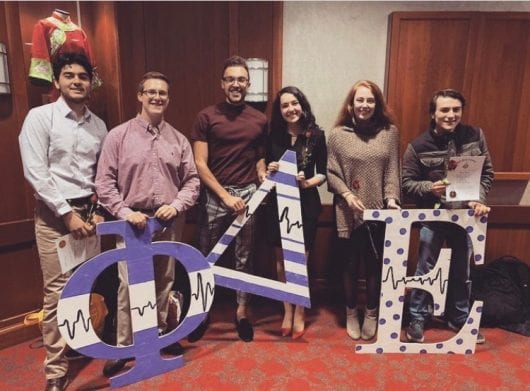
Phi Delta Epsilon members from left to right: Nojan Bojestani, Ryan Schnautz, Avery McMaster, Svitlana Shyrobokova, Rachel Brogee and Kevin Piczer. Credit: Courtesy of Phi Delta Epsilon
Ohio State’s Columbus campus has more than 60,000 enrolled students, and there are more than 1,400 student organizations at Ohio State, according to the Office of Student life website. Finding the right group of people can be overwhelming when faced with that many options.
Academic fraternities and sororities — like Phi Delta Epsilon, a co-ed pre-medical fraternity, or Delta Omega Kappa, an all-female sorority for pre-health majors — are among those organizations.
According to the Office of Student Life’s student organization directory, there are more than 20 academic sororities and fraternities on campus.
Avery McMaster, vice president of recruitment for PhiDE and a second-year in biology and Spanish, said PhiDE is different from social fraternities because of the academic focus.
“We try to focus on purely academic and professional enrichment, but we do have a social event every once in a while,” he said.
DOK has a similar objective — emphasizing community in academic-based fraternities and sororities, Alyssa Kurkul, recruitment chair of DOK and a fourth-year in health sciences, said.
“I really think you’ll never find a group of girls who are going to be as supportive,” Kurkul said. “Girls in this college are competitive and girls, in general, are just as competitive.”
Kurkul said DOK’s main goal is to create an empowering environment among women in these fields.
Both Kurkul and McMaster said their organizations’ laid-back recruitment processes can be a big difference between social and academic chapters. Kurkul said DOK recruits no more than 100 girls per semester, making DOK a smaller sorority.
The biggest social event at PhiDE also doubles as its biggest fundraiser. The anatomy fashion show — held at the Ohio Union Feb. 23 — is an event that allows PhiDE members to show off their knowledge by painting the human body on models and having them walk the runway, McMaster said.
Rachel Brogee, vice president of PhiDE and a third-year in Spanish, said the fashion show raised about $4,300 this past year, and the chapter is hoping to raise $5,000 this year.
Sarah Cummins, DOK new member co-chair and a fourth-year in neuroscience, said she wanted to surround herself with people in a similar stage of life.
“Before I heard about DOK, I wanted to find a group of women who do what I do,” Cummins said.
Not only are the companionships made in these organizations important, but so is the networking and career preparation, McMaster said. According to the American Association of Medical Colleges, the national average acceptance rate to medical school is about 42 percent.
“Eighty-six percent of our members who apply to medical school, their first try, get in,” McMaster said.
Correction: A previous version of this story incorrectly referred to Avery McMaster with she/her pronouns. That has since been corrected.


